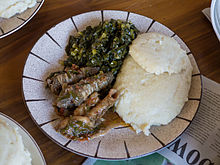Sadza
 A meal of sadza (right), greens, and goat offal. The goat"s small intestines are wrapped around the small pieces of large intestibes before cooking. | |
| Type | Porridge |
|---|---|
| Main ingredients | White maize (mealie-meal) |
Sadza in Shona (isitshwala in isiNdebele, or pap, vuswa or bogobe in South Africa, or nsima in Chichewa language, or Ugali in East Africa) or phaletšhe in Botswana, is a cooked cornmeal that is the staple food in Zimbabwe and other parts of Southern Africa.
Sadza is made with finely ground dry maize/corn maize (Mealie-Meal). This maize meal is referred to as hupfu in Shona or impuphu in Ndebele. Despite the fact that maize is actually an imported food crop to Zimbabwe (c. 1890), it has become the chief source of carbohydrate and the most popular meal for indigenous people. Locals either purchase the mealie meal in retail outlets or produce it in a grinding mill from their own maize.
Zimbabweans prefer white maize meal. However, during times of famine or hardship, they resorted to eating yellow maize meal, which is sometimes called "Kenya", because it was once imported from that nation. Before the introduction of maize, sadza was made from zviyo finger millet flour.
Traditionally, sadza was eaten from a communal bowl, but now it is typically served on individual plates. It is generally eaten with the right hand without the aid of cutlery; often rolled into a ball before being dipped into a variety of condiments such as sauce/gravy, sour milk, or stewed vegetables.
Notable foods eaten with sadza
Meat is known as nyama in Shona.
- Red meat – includes beef, mutton, goat, and game meat
- Cow hoof – amanqgina, mazondo
- Oxtail
- Other food stuffs include intestine (tripe), offal, ezangaphakathi (includes amathumbu, amaphaphu, isibindi, utwane, ulusu, umbendeni) in Ndebele known as matumbu, sun-dried vegetables known as uMfushwa/Mufushawa, and many more
- White meat – includes huku or inkukhu - chicken meat, hove - Fish
- Fish (inhlanzi in Ndebele), including the small dried fish Kapenta
- Mopane worms / madora / amacimbi – edible moth caterpillar
- Spring greens – known as imibhida in the Ndebele Language, muriwo in the Shona Language
- Sugar Beans – known as indumba in Ndebele, nyemba Shona
- Cabbage
- Derere Delele – okra
- Cleome gynandra (ulude in Ndebele) / nyevhe in Shona
- Pumpkin – leaves known as Muboora in shona or ibhokola in Ndebele
- Soured milk natural yogurt (known as amasi in Ndebele or Nguni languages in South Africa, mukaka wakakora in Shona, or lacto
- Soya Chunks
- Soups and stews
- Sadza and ox bone
See also
References
The following books, set in Zimbabwe, discuss the characters' eating the Zimbabwean staple, sadza:
- Dangarembga, Tsitsi (1988). Nervous Conditions. Ayebia Clark Publishing. is a semi-autobiographical novel focused on the story of a Rhodesian family in post-colonial Rhodesia (present-day Zimbabwe), during the 1960s.
- In Douglas Rogers' book The Last Resort: A Memoir of Zimbabwe (September 2009), Naomi, an elderly Malawian woman whom Rogers calls "Mrs. John", brings her husband, John Muranda, the other John, John Agoneka, and Rogers bowls of warm sadza, which Rogers explains "Mrs. John" cooks daily, over a wood fire outside the Murandas' home. (Crown/Random House, LLC, ASIN: B002PXFYIS, Chapter 4, page 23).
